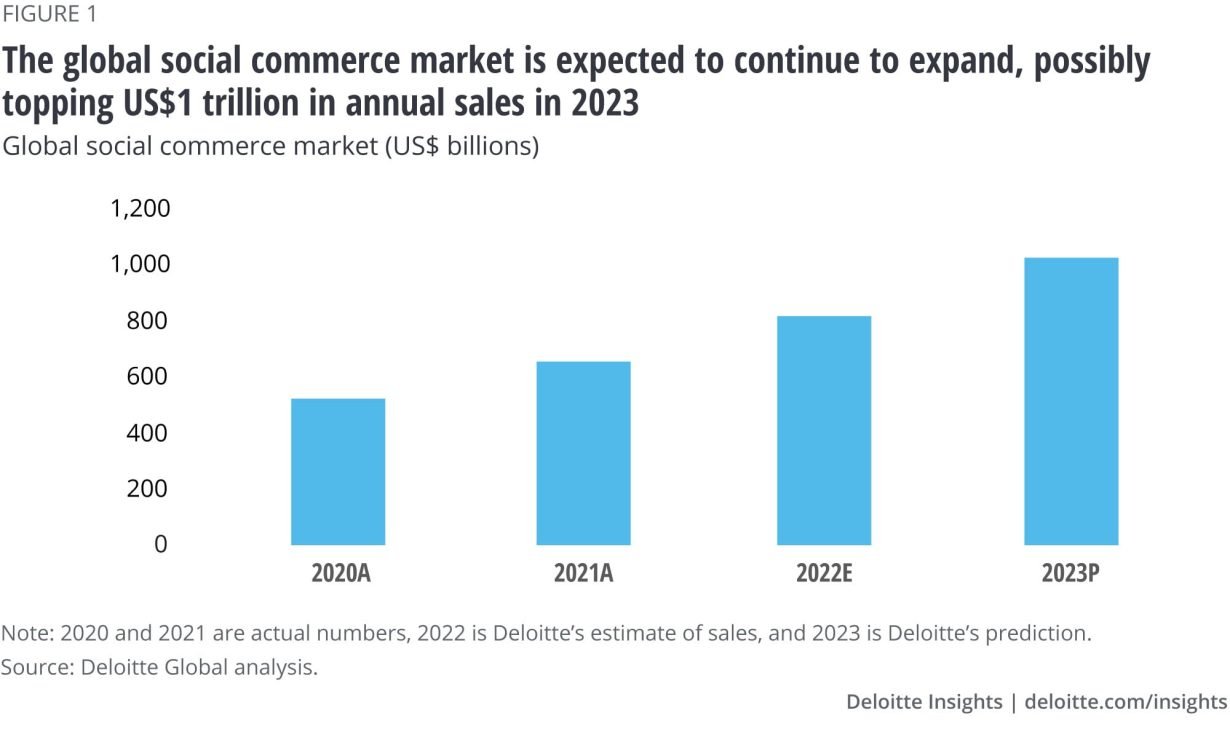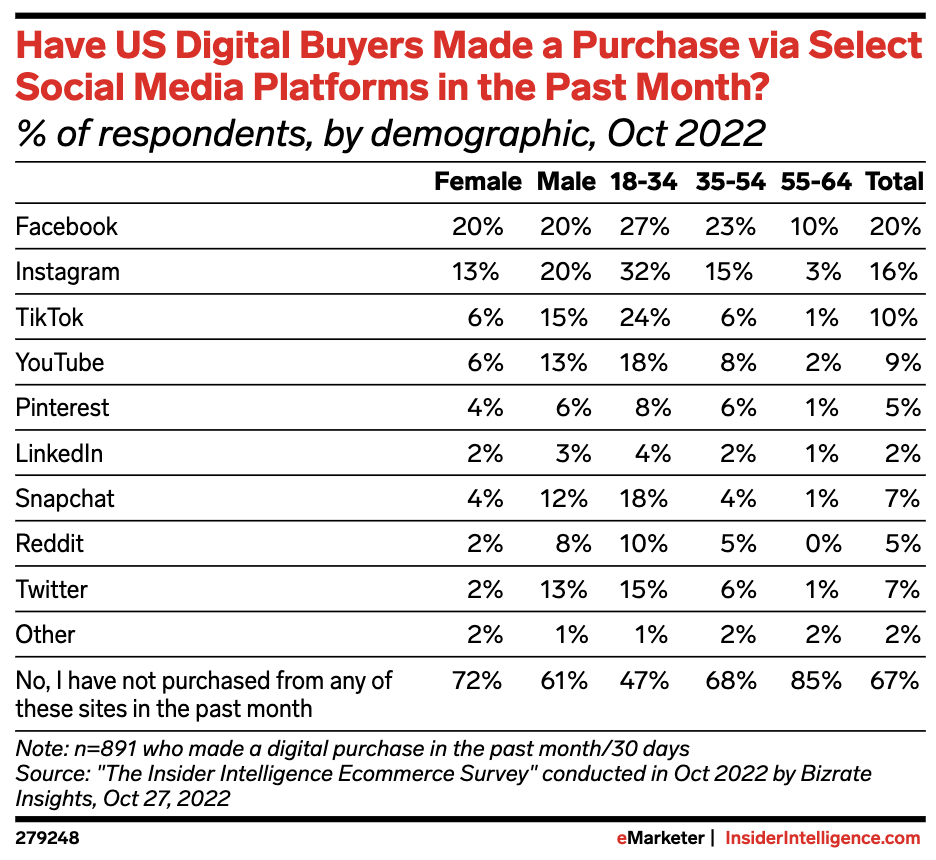Everywhere you look, new social platforms seem to be popping up and vying for consumer attention. Even the power players have been scrambling for new ways to differentiate themselves from the pack to prove their value to their users (and to advertisers).
The pursuit of both ad dollars and user growth has fueled the rise of social commerce. The traditional role social plays in the marketing mix basically consists of showing your brand and products on the platform and linking out to your website; now it’s possible to actually buy directly on social media.
But that’s still not the whole story: social media can drive commerce in more ways than ever before. Brand discovery is happening more and more on social platforms, especially for gen z, whether or not the transaction occurs there or on Amazon or in a physical store. A consumer could interact with an influencer on a platform, then go to LTK to find out more about a product and purchase on the brand’s site.
We look at a much wider definition of social commerce: the role social plays in the commerce journey as a whole. Taking a more expansive view makes it clear how much innovation is happening.
Not only is social commerce a great way to build relationships with potential customers and deliver a more seamless shopping experience, but it also shortens the sales funnel, giving your brand a big advantage when driving conversions.
So how can you set your business up for success in the ever-changing social landscape? Let’s look at the current trends shaping social commerce and driving new developments, then break down the pros and cons.
Success in social commerce means staying on top of what’s trending
According to Statista, social commerce is set to account for 5.2% of all ecommerce transactions by 2025. Deloitte predicts that social commerce will top $1 trillion in sales in 2023 and will only continue to grow as social platforms develop more sophisticated shopping capabilities.

Source: Deloitte
There’s no time like the present to take advantage of social commerce trends and incorporate them into your strategy before consumers get inundated with options and look for other avenues to complete their interactions or purchases.
Every brand has different needs and challenges, but some critical trends are worth considering right now:
- Leveraging live shopping: Forget QVC or the Zoom shopping sessions of the past. Live streaming lets brands showcase new products and services while connecting with their customer on a one-on-one level. An influencer-driven live shopping strategy can also help your brand get in front of new audiences, drive sales, and inject a human connection into your marketing. And it’s not one-and-done; you can also save a livestream and continue the discussion at a later date.
- Partnering with micro-influencers: According to Instagram, 87% of people using Instagram shopping were swayed by influencers in their purchase decisions. Micro-influencers are cheaper than their million-follower brethren, and often inject their own creator experience into content they make for a brand that can lend more authenticity to creative assets. These affordable partnerships can help influencers play a role at every stage of the customer journey.
- Selling through chatbots: Upgrading your AI capabilities with a chatbot can alleviate customer service stress while cutting costs. They can also make sales. The arrival of tools like ChatGPT is a harbinger of where the future is headed and how much these solutions are capable of when they are trained and used correctly (with plenty of human oversight).
- Turning social platforms into discovery-to-purchase platforms: Younger users are more likely to turn to social platforms to research and evaluate brands. By integrating shoppable capabilities into your social strategy, you can address the need for authentic reviews and social proof with the ability to purchase, all on the same platform.
Instagram shopping, Facebook shops, and Pinterest buyable pins are just a few examples of transactional social commerce offerings from major platforms. Other options don’t necessarily require the creation of a shop, including TikTok, Facebook, and Instagram Live, where the customer can make the purchase as the content is being shared.

Source: eMarketer
Weighing the pros and cons of investing marketing budget in transactional social commerce
If you’re considering reworking your social strategy to take advantage of new commerce capabilities on social media channels, there are a couple of things you should take into account.
It’s simplest to start with the pros: the most obvious is that adding transactional capabilities to your social strategy makes the shopping experience seamless, reducing the customary purchasing friction that can happen in traditional social campaigns where a customer has to leave the platform and head somewhere else to make a purchase.
Ariana Grande’s song “7 Rings” might sum up the benefits to the customer experience best: “I see it, I like it, I want it, I got it.” A simple tap takes you all the way from discovery to purchase.
You can also inject more engagement into the shopping experience by introducing interactive elements or through influencer partnerships that let you take advantage of some of the inherent benefits of social channels.

Source: Instagram
That’s not to say there aren’t challenges. Any time a piece of technology offers a new feature, there are growing pains as the platform develops and tests new capabilities, and social transactions will continue to evolve as the platform gets a better idea of how people use it or what’s not working.
Social commerce is also built for shoppers versus sellers and its reach is limited to the social sphere, so consumers need to be social-savvy to follow through on any purchases. On top of this, because each platform has its own audience, it can be time-consuming to maintain transactional campaigns or stores across multiple channels and stay engaged with your customers.

Source: TikTok Shopping
There are also more critical business functions to take into account. You need to consider how social shops or campaigns integrate with your inventory management and fulfillment. There’s also the matter of the different fees platforms take for any in-app or in-platform purchases and how that affects your margin/profit calculations.
Brands need to assess if the incremental conversion rate of a frictionless experience will offset the cost based on volume, then potentially change product strategies based on product-level margin.
If you’re able to invest the time, money, and effort needed to integrate transactional social commerce into your marketing strategy, the rewards could be significant. The world seems to be moving toward a more social-focused internet, including every facet of commerce from discovery to research to purchase.
It’s time to start exploring what these new capabilities could do for your business and meet your customers where they are.







Responses